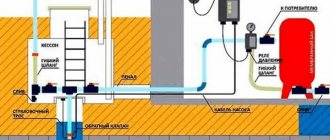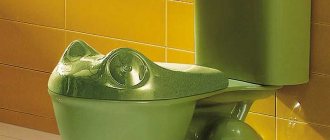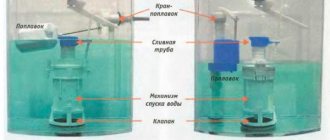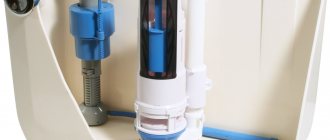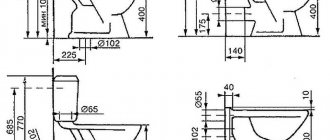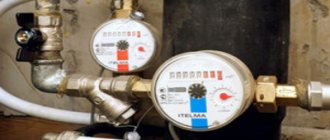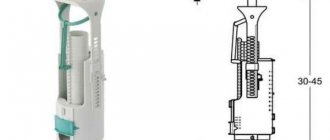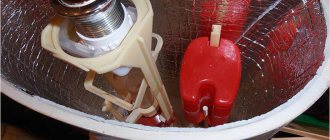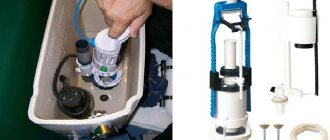- The main differences between tanks
- The main elements of cisterns
- Principle of operation
- Criteria for choosing a cistern
- Standard volumes and mechanisms
Nowadays, almost every home can boast of already installed plumbing, which creates the most comfortable living conditions. Among all types of structures, toilet devices are of particular importance. Thanks to the high practicality and excellent performance achieved through the ability to flush water, toilets are so important and special. But they also have their own elements, without which normal operation would not be possible - this is a water tank. This part is a bowl made of ceramic or other material that houses drainage mechanisms and water. The volume of the toilet tank can vary widely. It all depends on the number of household members, the shape of the toilet itself and much more.
Tank volume options
What types of water drainage systems are there?
Diagram of the drain tank.
Drain containers come in various types and designs. Models with a two-button system are available. When you press one button, from 6 to 8 liters of water descends from the tank, the other - from 2 to 4 liters is drained. This, of course, is a very convenient mechanism that promotes economical use of water, which is especially valuable during water shortages.
The standard volume of water in a toilet flush tank is 6 liters, it is even recorded in some GOST standards. This is enough to effectively flush away waste. But the tank volume can be 8 or 10 liters. Some toilets are equipped with economical flush systems, which allow you to use only part of this volume, the so-called half flush. It happens that a complete drain is not always necessary - for example, to flush away a small amount of human waste, half the container is enough. This function is useful for those for whom saving water is important (meters are installed).
There are tanks with automatic draining. This drainage system saves you from flushing the water manually. It works using a sensor that reacts to the presence of a person: the presence of a person is detected, and when he leaves, the sensor gives a command to drain the waste. This flushing system is especially convenient and useful in shared toilets - in offices, institutions, industrial premises; it is as hygienic as possible, since it eliminates direct contact with the toilet. But it can also be installed in a home toilet.
Distances
It’s good for those who have a large room allocated for a bathroom or toilet. If yours is not so large, you need to know the minimum tolerances for the distance from the toilet to nearby “structures” and devices.
Distance from the toilet to the wall: according to standards - at least 25 cm
- There should be at least 25 cm between the bidet and the toilet.
- There must be at least 60 cm of free space in front. That is, the distance from the edge of the bowl to the door or wall in front is 60 cm or more.
- There should be at least 25 cm of free space on the sides. This is not enough, but tolerable. Comfortable distance - 35 cm.
Now you draw a plan of your bathroom, mark the minimum distances and see what size toilet will fit into your toilet. So it's simple.
Choosing a cistern
When installing a drain tank, a shut-off valve must be installed to shut off the water, since the shut-off device should be inspected annually
The valve is the most important and complex part of the toilet kit. Its task is to ensure complete and quick flushing of the contents of the toilet bowl, and then automatically fill with water to a certain volume
This device is often sold complete with a toilet.
Quiet operation is one of the main signs of the quality of the drain tank
Pay attention to this - a strong noise when filling the drain tank with water indicates incorrect installation or the presence of a manufacturing defect in the product. To insure against this, it is better to purchase toilets in highly specialized stores, where you can get a guarantee on them
When choosing a flush container, look at the type of tank and its location relative to the toilet. There are samples with both a separate location and a joint one. A separate arrangement usually involves a suspended tank, which is attached to a specially designed frame. The container can be placed at any height according to your wishes. In joint models, it is mounted to the toilet (from above) and can be attached or solid.
Construction of a standard tank
The valve mechanism of a conventional tank includes the functions of filling the tank, shutting off the water when overflowing, and flushing. The container is filled with water from the water supply system through the inlet pipe rod. When the water volume reaches a certain level, a lever driven by a float closes the supply valve.
Flushing is carried out through the drain valve and is activated by pressing or pulling the head of the part. Overflow of water in the toilet cistern is eliminated using a special tube. The main problems that can be encountered during the operation of a toilet flush cistern are caused by a malfunction of the flush or fill valve.
The chemical composition of tap water may affect the correct operation of the product. However, if the plumbing equipment is of high quality, troubleshooting can be done easily and quickly.
If the toilet tank adjustment is carried out by a professional, a quick visual inspection will be enough to diagnose the breakdown. Troubleshooting won't take much time either. Of course, if the equipment is of poor quality, this process may take longer.
How to replace the flush mechanism in a toilet cistern
I'm curious, how did you set the volume of the tank? Was it written in the passport? For example, I still don’t know what the volume of my tank is, somehow I haven’t thought about it. I can, of course, buy a 9-liter one, but the sellers simply tried to prove to me that the standard is 6-liter, but look at any installation - it says 9-liter tank.
Forgive me for the piquant questions, but what did you use before the renovation? Did you have enough water from the regular tank of your old toilet? If water consumption does not matter, then take 9 liters just to be sure.
Last edited by Mila Wed Jan 26, pm, edited 2 times in total a. Driving piles from the water, on the water, strengthening the coastline. Wed Nov 16, am AndyB. How to drill a water well at your dacha yourself? Tue Oct 02, pm Kroul. Sun May 29, am Goshia. Is it possible to cut out a hot water pipe in an apartment? Tue Apr 20, pm Goshia.
What to do? Sat Mar 10, pm Plumber. You cannot start topics You cannot reply to messages You cannot edit your messages You cannot delete your messages You cannot add attachments.
Installation Tips
If the toilet tank has a separate structure and is mounted as a wall-hung one, then reliable beams should be installed to secure it to the wall. It is best to use metal brackets that are fixed into concrete with anchors or screws with dowels. The weight of a cast iron or steel container filled with 6 liters of water is quite large and requires reliable vertical fixation.
The supply pipe at the junction of the lower opening of the tank and the drain bowl must be sealed with a rubber gasket and treated with silicone or sealant.
The compact tank, installed directly on the toilet, must also be securely connected. For this purpose, bolts are used, usually included in the kit. Rubber gaskets must be placed at the connection points. The drain hole leading from the tank into the bowl must be equipped with a cuff and lubricated with an airtight solution.
All tubes, inlet and outlet hoses, and corrugations must be tightened all the way, ensuring a reliable seal. It would also be a good idea to check that the tank is installed strictly horizontally.
Types of toilet flush tanks
Diagram of the device and principle of operation of a floatless tank.
Drain containers are made from various materials and are cast iron, plastic and earthenware. High cast iron cisterns are almost never installed; plastic tanks in the middle position are light and convenient, but they do not provide reliable support for the fittings of the drain tank and do not quite fit porcelain and earthenware toilets.
The most common now are porcelain flush cisterns with a low location, those that are simply installed on the toilet.
Cisterns vary greatly in shape and size. If previously the parallelepiped shape with the front side protruding dominated, now manufacturers make a wide variety of shapes, extending them upward or stretching them along the wall, so that they take up a minimum of space and can be squeezed into a corner or in a technical cabinet.
Plastic cisterns come in high, medium and minimized volumes. Their main advantages: strength (they do not burst or break), lightness, ease of installation and simplicity of fittings. The water can be drained either all at once or in small portions - just pressing on the protruding part of the float is enough.
Earthenware cisterns are heavier than plastic ones and more fragile; they are installed on top of the toilet and have a more complex internal structure, consisting of several moving metal parts. Tanks of modern models make it possible to flush water in different ways: the entire volume at once (from 6 to 8 l) or part of it (from 3 to 6 l), or they flush water in parts while the drain button is pressed.
The design of the toilet flush tank consists of filling, draining and overflow devices. The volume of the tank is replenished with water through a metal or plastic tip of the supply pipe, which is closed by a float valve when the tank is filled to a certain volume.
Water is drained using a drain valve, which is driven by pressing or pulling the valve head. Excess water is transferred through an overflow tube. Many malfunctions that arise in the operation of the toilet flush cistern are associated with the operation of 2 valves - the flush valve and the fill valve.
The quality of the toilet is largely influenced by the quality of the water, but if the device is reliable, then problems can be fixed quickly. A professional just needs to lift the lid of the container and watch it fill and drain water, determine the cause of the problem and fix it. If the mechanism is not important, you will have to tinker.
When buying a toilet kit, you should keep in mind that imported flush cisterns usually have a rather complex internal structure that only works reliably with good water pressure. Since the work of plumbing fixtures is not demonstrated in stores and is not checked in any way, when purchasing an imported toilet with a tank, you need to know in advance the pressure of the water supplied to your home and ask how such plumbing fixtures work for other consumers.
Features of measurements
When buying plumbing fixtures, you need to proceed not only from the size of the toilet room and the desired size of the toilet, but also take into account the features and size of the outlet pipe . The gap between the toilet and the walls of the room depends on the type of connection of the plumbing fixture to the sewer.
Particularly whimsical in this case are devices with a bottom type of outlet . They cannot be reinstalled with minimal losses in the finishing of walls and floors. Major reconstruction will be required. Therefore, when buying a toilet, you need to take into account not only its dimensions along the contours, but also how much space it will take up when fully assembled.
From the materials on our website, you can also find out which toilet is best to choose, taking into account other parameters - material of manufacture, type of construction, etc.
All about the toilet cistern
Not all toilet flush tanks have the same water capacity. It is generally accepted that the standard volume of water in the tank should be 6 liters. These are outdated GOST standards, when toilet flush tanks did not have an economical flush system. There are tanks on sale with a water volume of liters, they are already equipped with a modern economic flush system - half flush. This is a very good feature that allows you to significantly save water in a house that has water meters installed. The toilet tank has a volume of 6 to 10 liters. Different manufacturers produce different designs of water drainage tanks. Economical designs are equipped with two buttons that allow for draining different volumes of water, half the tank and the entire tank.
The main consumption through the toilet is one liter flush. We installed a tank with a separate drain, so less water flows out.
Saving natural resources has long become a habit for most developed countries of the world. A habit that allows you to significantly save your family budget. The price of 1 liter of water from a domestic water supply system may seem insignificant. But when calculating annual costs, very tangible amounts emerge.
To save water, my mother put a full plastic bottle in the toilet cistern. Savings are nothing like that for five family members... Lifehack Savings Text. No duplicates found.
Not all toilet flush tanks have the same water capacity. It is generally accepted that the standard volume of water in the tank should be 6 liters. These are outdated GOST standards, when toilet flush tanks did not have an economical flush system.
Any plumbing makes our life more comfortable. Thanks to its practicality, durability and the ability to drain used liquid, this sanitary and hygienic device is so popular.
It is difficult to imagine a modern home whose bathroom would not be equipped with modern, comfortable plumbing equipment. Naturally, you can’t do without a toilet in a restroom. The efficiency of its operation is determined, among other things, by the mechanism for draining water. The drainage systems that exist today are highly functional and efficient.
Now almost every home can boast of already installed plumbing, which creates the most comfortable living conditions
Among all types of structures, toilet devices are of particular importance. Thanks to the high practicality and excellent performance achieved through the ability to flush water, toilets are so important and special
But they also have their own elements, without which normal operation would not be possible - this is a water tank. This part is a bowl made of ceramic or other material that houses drainage mechanisms and water.
Question for owners of comfortable houses. How many cubic meters is the capacity? How many people?
Materials for the manufacture of sanitary products
Modern industry produces similar equipment of a wide variety of sizes and configurations, so it is now possible to choose ergonomic models that allow you to install them anywhere and save bathroom space.
Toilet flush tanks are made using materials such as metal (cast iron and stainless steel), plumbing ware and plastic. Hanging drain containers made of cast iron are practically out of use, and plastic products, located low on the wall, do not have sufficient strength to reliably hold the shut-off valves and look rather poorly combined with a ceramic toilet bowl.
Today, the most widely used models of plumbing fixtures are those in which the earthenware tank is connected directly to the toilet.
Plastic waste tanks are found in high, medium and low volume classes. Water in such devices can be drained either completely or in small parts. They are highly durable, easy to install and connect. You can also note the high durability of the devices, which is ensured by the simplicity of the design.
Toilet cistern volume
Life is becoming more expensive all the time, especially food, housing and communal services are also not lagging behind and annually increase tariffs for their services by a tidy sum, but wage growth for many has almost stalled. There are constantly not enough funds, so people are forced to think about saving in everything and look for ways to reduce costs. Everyone has long been accustomed to thinking that Russia has a lot of natural resources, including water, and they can spend it without looking. In essence, money is flowing away from us down the drain. Here are some ways to reduce your water consumption. Many do not cost any money but will reduce your water bills. This may seem like a small thing to some, but by retraining yourself in some ways, you will see what the benefits will be, especially if you installed a water meter for yourself, then quickly remember these tips: Most people, bending over the sink in the morning and evening to brush their teeth, open the water tap completely.
Why are trees protected?
Low temperatures primarily affect young trees that have not had time to build up protection from natural conditions. At low temperatures, the cambium, the thin layer between the bark and wood of seedlings, is damaged.
Cambium plays an important role in plant development. When the protective layer is damaged by frost, frost holes appear. They appear on trunks, since the frost resistance of the tree crown is higher.
It is difficult to determine damage. By the next cold weather, the size of the frost holes increases, and the damage to plant health progresses. Therefore, it is important to know how to save your garden from frost.
Technical specifications
The toilet tank contains internal mechanisms such as:
- ball valve that controls the water level;
- reverse action valve that protects against overflow;
- drain system fittings.
The toilet tank has a complex structure in some models. If this is an old-style container, then it contains three mechanisms: a body, a valve and a drain. The working process of the drainage system is simple. The plastic case houses a movable shutter, controlled by a button, in case the tank overflows, which drains excess water into the bathroom, bypassing the shutter. The overflow device is located inside the drain mechanism and has the form of a plastic pipe that rises and falls, regulating the level of water in the tank.
